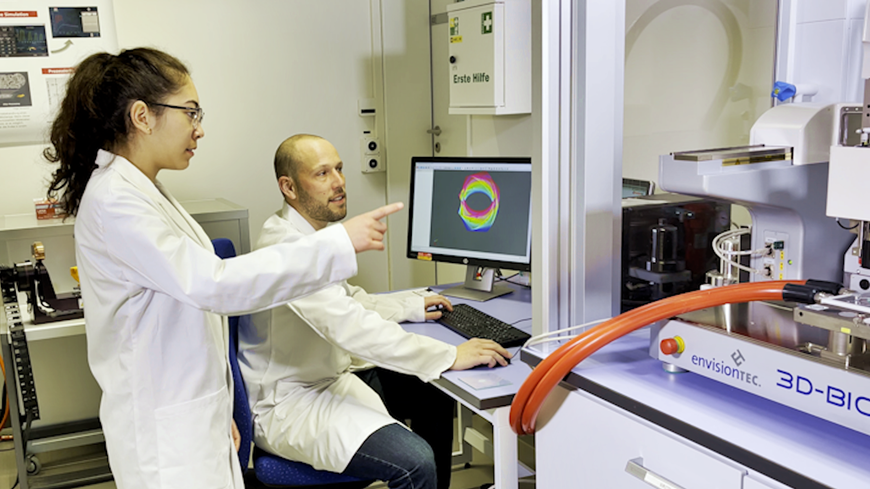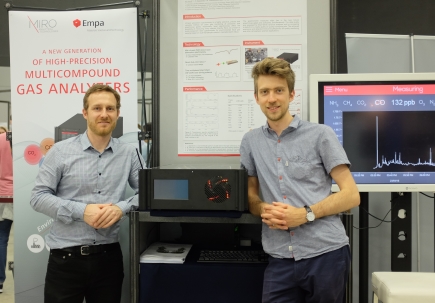Empa Spin-off develops new analyzer
Nine in one swoop
Atmospheric pollutants put a strain on the environment and harbor health hazards for humans. The Empa spin-off MIRO Analytical Technologies developed a technology to simultaneously analyze nine greenhouse gases and pollutants with only one device and at an unprecedented speed and precision.
Air pollution is a problem that affects us all. However, instruments to measure greenhouse gases and pollutants in the atmosphere are complex, expensive and usually consume a lot of energy as every gas is measured using a different method. Two researchers from Empa’s Laboratory for Air Pollution/Environmental Technology, Morten Hundt and Oleg Aseev, have developed a method that simplifies this process: Using only one device, they are able to detect nine greenhouse gases and air pollutants simultaneously. These also include nitrogen dioxide (NO2), which until now usually could only be measured indirectly, potentially distorting the results. “Our goal is to make air quality and greenhouse gas measurements easier, more accurate and cheaper,” says Hundt.
Pollutants from the exhaust pipe
The analyzer developed by MIRO can measure carbon monoxide (CO) and carbon dioxide (CO2), ammonia (NH3), nitric oxides (NO and NO2), laughing gas (N2O), ozone (O3), sulfur dioxide (SO2) and methane (CH4) with high precision. This may especially become relevant in the course of the political discussions on vehicle bans in cities, like in Germany recently, as a proportion of these pollutants stems from car emissions.
Not only can the high-precision measuring instruments developed by MIRO be used in the context of exhaust gas emissions. As part of the Paris Agreement, the international community of states regularly develops new plans to curb greenhouse gas emissions such as carbon dioxide, nitrous oxide or methane. Whether or not these measures will actually succeed needs to be verified, however. This requires more accurate measurements, which then serve as input values for detailed atmospheric models. These measurements are conducted by scientists from government measuring networks, such as NABEL in Switzerland (“Nationales Beobachtungsnetz für Luftfremdstoffe”). Here, too, the new MIRO technology can make work easier, as Empa researcher and NABEL project leader, Christoph Hüglin, confirms: “The MIRO measuring device is a highly promising alternative to the instruments currently available.”
Three double quantum cascade lasers are better than one
The new approach is based on laser absorption spectroscopy and combines three double quantum cascade lasers in one device, which enables various gases to be measured with high precision. The laser’s light is absorbed by the gas molecules. “The more light is absorbed, the higher the concentration of the relevant pollutants in the analyzed air sample. In other words, it’s a direct and absolute measuring method,” explains Hundt. “We selected the spectral range so we didn’t have to worry about any cross-sensitivity,” adds Aseev. Hundt and Aseev already demonstrated that their idea works perfectly. Founded in February, the start-up MIRO Analytical Technologies is initially looking to position itself on the climate science and air quality monitoring market with its novel analyzer. But the range of potential applications is vast. For instance, its use in industry or in the security sector is also conceivable.
Download high-res images here
With their analyzer, Morten Hundt and Oleg Aseev won the „Innovations Village Competition“ at this year’s SPIE Photonics Europe 2018. More about the event here. And Optics.com has written an article with some of the presented innovations of the competition.
MIRO Analytical Technologies is not the only Empa spin-off to use optical spectrometers. IRsweep, founded in 2014, specializes in molecular analyses. The application areas for the spectrometer developed by IRsweep include real-time observations of enzymatic reactions and the monitoring of chemical reactions.










